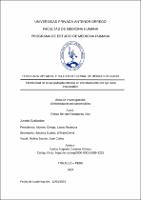Mostrar el registro sencillo del ítem
Efectividad de la luz pulsada intensa en el tratamiento del ojo seco evaporativo
| dc.contributor.advisor | Cisneros Gómez, Carlos Augusto | |
| dc.contributor.author | Pomatanta Díaz, Renzo Renato | |
| dc.creator | Pomatanta Díaz, Renzo Renato | |
| dc.date.accessioned | 2024-03-20T16:22:42Z | |
| dc.date.available | 2024-03-20T16:22:42Z | |
| dc.date.issued | 2024 | |
| dc.identifier.uri | https://hdl.handle.net/20.500.12759/24971 | |
| dc.description.abstract | Objetivo: Determinar si en pacientes con diagnóstico de ojo seco evaporativo el tratamiento con luz pulsada intensa es más efectivo que el tratamiento convencional. Métodos: Estudio con diseño de cohorte retrospectivo y observacional. La población diana consistió en pacientes con diagnóstico de ojo seco evaporativo, y la población accesible incluyó a aquellos que acudieron a la clínica Oftalmocenter entre enero de 2021 y diciembre de 2022 y fueron diagnosticados con esta condición. Se establecieron criterios de inclusión y exclusión para conformar dos cohortes: Cohorte 1 (48 pacientes), que recibió tratamiento con LPI, y Cohorte 2 (48 pacientes), que recibió tratamiento convencional. Se recopilaron datos clínicos y oftalmológicos, incluyendo el Índice de sintomatología del ojo seco (OSDI), tiempo de ruptura de película lagrimal (NIKBUT), meibografía y enrojecimiento conjuntival. Resultados: Dentro de los resultados se encontró una mayor proporción de mujeres en el grupo de tratamiento con luz pulsada intensa en relación a hombres (41,67% vs 14,58%; p = 0,003). Las variables OSDI (38,35 ± 13,60 vs 48,77 ± 17,35; p = 0,001) y M2 (2,23 ± 0,74 vs 1,84 ± 0,68; p = 0,009) en el pretratamiento resultaron con diferencias estadísticamente significativas; y en el postratamiento, el OSDI (30,90 ± 18,30 vs 39,56 ± 20,75; p = 0,032) y el M2 (2,13 ± 0,83 vs 1,78 ± 0,72; p = 0,027) mantuvieron las diferencias, aunque entre el pretratamiento y postratamiento disminuyeron los valores de OSDI y M2. Dentro de la seguridad del tratamiento con LPI, solo dos pacientes de la cohorte 1 presentaron leve enrojecimiento facial que cedió a las 24 horas. Conclusión: Este estudio sugiere que el tratamiento con LPI podría ser más efectivo que el tratamiento convencional en pacientes con ojo seco evaporativo. Se observaron mejoras en los síntomas y en la morfología de las glándulas de Meibomio en el grupo tratado con LPI. Sin embargo, es necesario más investigaciones y ensayos clínicos para confirmar estos hallazgos y evaluar la seguridad a largo plazo de la LPI en este contexto | es_PE |
| dc.description.abstract | Objective: To determine if in patients diagnosed with evaporative dry eye, treatment with intense pulsed light (IPL) is more effective than conventional treatment. Methods: This study employed a retrospective and observational cohort design. The target population consisted of patients diagnosed with evaporative dry eye, and the accessible population included those who attended the Oftalmocenter clinic between January 2021 and December 2022 and were diagnosed with this condition. Inclusion and exclusion criteria were established to form two cohorts: Cohort 1 (48 patients), which received IPL treatment, and Cohort 2 (48 patients), which received conventional treatment. Clinical and ophthalmological data were collected, including the Ocular Surface Disease Index (OSDI), tear film breakup time (NBUT), Meibography, meniscus height, and conjunctival redness. Results: Within the results, a greater proportion of women was found in the intense pulsed light treatment group (41.67% vs 14.58%; p = 0.003). The variables OSDI (38.35 ± 13.60 vs 48.77 ± 17.35; p = 0.001) and M2 (2.23 ± 0.74 vs 1.84 ± 0.68; p = 0.009) in pretreatment They resulted with statistically significant differences; and in the post-treatment, the OSDI (30.90 ± 18.30 vs 39.56 ± 20.75; p = 0.032) and the M2 (2.13 ± 0.83 vs 1.78 ± 0.72; p = 0.027) maintained the differences, although between pre-treatment and post-treatment the OSDI and M2 values decreased. Within the safety of treatment with IPL, only two patients in cohort 1 presented mild facial redness that subsided after 24 hours. Conclusion: This study suggests that IPL treatment may be more effective than conventional treatment in patients with evaporative dry eye. Improvements in symptoms and Meibomian gland morphology were observed in the IPL-treated group. However, further research and clinical trials are needed to confirm these findings and evaluate the long-term safety of IPL in this context | es_PE |
| dc.description.uri | Tesis | es_PE |
| dc.format | application/pdf | es_PE |
| dc.language.iso | spa | es_PE |
| dc.publisher | Universidad Privada Antenor Orrego | es_PE |
| dc.relation.ispartofseries | T_MED_3782 | |
| dc.rights | info:eu-repo/semantics/openAccess | es_PE |
| dc.rights.uri | https://creativecommons.org/licenses/by/4.0/ | es_PE |
| dc.source | Universidad Privada Antenor Orrego | es_PE |
| dc.source | Repositorio Institucional - UPAO | es_PE |
| dc.subject | Ojo seco evaporativo | es_PE |
| dc.subject | Luz pulsada intensa | es_PE |
| dc.subject | Tratamiento convencional | es_PE |
| dc.title | Efectividad de la luz pulsada intensa en el tratamiento del ojo seco evaporativo | es_PE |
| dc.type | info:eu-repo/semantics/bachelorThesis | es_PE |
| thesis.degree.level | Título Profesional | es_PE |
| thesis.degree.grantor | Universidad Privada Antenor Orrego. Facultad de Medicina Humana | es_PE |
| thesis.degree.name | Médico Cirujano | es_PE |
| thesis.degree.discipline | Medicina Humana | es_PE |
| dc.subject.ocde | https://purl.org/pe-repo/ocde/ford#3.02.27 | es_PE |
| renati.advisor.orcid | https://orcid.org/0000-0003-1889-3225 | es_PE |
| renati.author.dni | 70747064 | |
| renati.advisor.dni | 17802173 | |
| renati.type | https://purl.org/pe-repo/renati/type#tesis | es_PE |
| renati.level | https://purl.org/pe-repo/renati/level#tituloProfesional | es_PE |
| renati.discipline | 912016 | es_PE |
| renati.juror | Moreno Ortega, Laura Alejandra | |
| renati.juror | Becerra Suarez, William David | |
| renati.juror | Molina Socola, Juan Carlos | |
| dc.publisher.country | PE | es_PE |
Ficheros en el ítem
Este ítem aparece en la(s) siguiente(s) colección(es)
-
Medicina Humana [2984]




